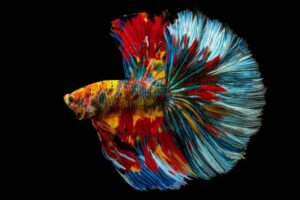It is well-known that bettas are highly territorial fish with solitary habits. Male betta fish will often fight till serious injury or death when they encounter one another, but this behavior is less common in females.
Female betta fish can tolerate living with tank mates and occasionally each other if the tank conditions are ideal. They can be housed with other small and peaceful fish or invertebrates that can live in tropical freshwater aquariums. Keeping female betta fish with tank mates requires careful planning and plenty of aquarium maintenance, which is doable for experienced keepers.
If you are looking for the most ideal tank mates to pair with your female betta fish, then this article is for you.
Overview Of Female Betta Fish

Female betta fish are found in an assortment of colors and patterns like their male counterparts.
©Arunee Rodloy/Shutterstock.com
| Scientific name: | Betta splendens |
| Origins: | Southeast Asia |
| Size: | 2 to 3 inches |
| Lifespan: | 3 years |
| Diet: | Carnivores |
| Minimum tank size: | 5 gallons |
| Water temperature: | 75° to 80° Fahrenheit (23° to 26° Celsius) |
Keeping Female Betta Fish In Community Aquariums
Female betta fish generally make poor additions to community aquariums because of their aggressive and territorial behaviors. However, there are a few fish and invertebrates that are compatible enough to be housed with them.
Before choosing tank mates for your female betta fish, you first need to ensure that their aquarium conditions are suitable.
- The tank needs to be over 10 gallons if you house female bettas with other fish.
- A heater and filter are essential as all bettas require warm, clean water to thrive.
- The tank needs to be completely cycled as good water quality is key for healthy betta fish.
- The water temperature should be set between 75° to 80° Fahrenheit.
- The female betta must be fed a healthy carnivorous diet.
- Large, aggressive, long-finned, or tank mates with different water quality requirements should be avoided.
Ideal Tank Mates Reviewed
Let’s take a look below at the various tank mates you can pair with female betta fish.
1. Neon Tetras (Paracheirodon innesi)
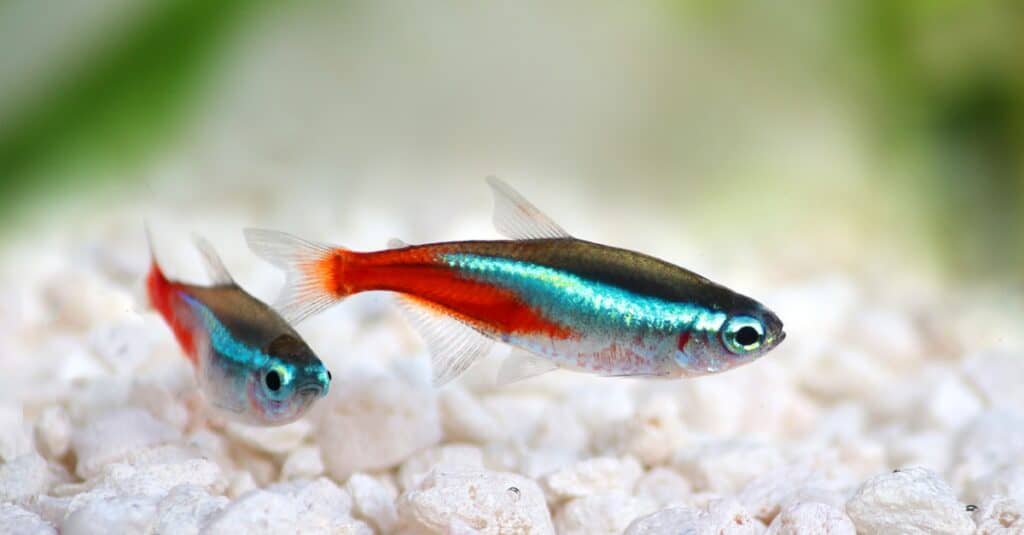
You need to keep neon tetras in groups of six or more because they are schooling fish.
©iStock.com/Mirko_Rosenau
Neon tetras are small schooling fish recognized by their vibrant blue and red bodies. They can be found inhabiting the Amazon River Basin in South America, where they form large schools. Neon tetras generally grow 1.5 inches long, which is slightly smaller than many female betta fish. They do not require very large tanks, so a 10 to 20-gallon-long aquarium can comfortably house a small school of neon tetras and a single female betta fish.
Planted female betta fish aquariums will create a naturalistic environment in which neon tetras feel safe. Live plants such as hornwort, Vallisneria, and Amazon swords are preferred by neon tetras.
2. Kuhli Loaches (Pangio kuhlii)
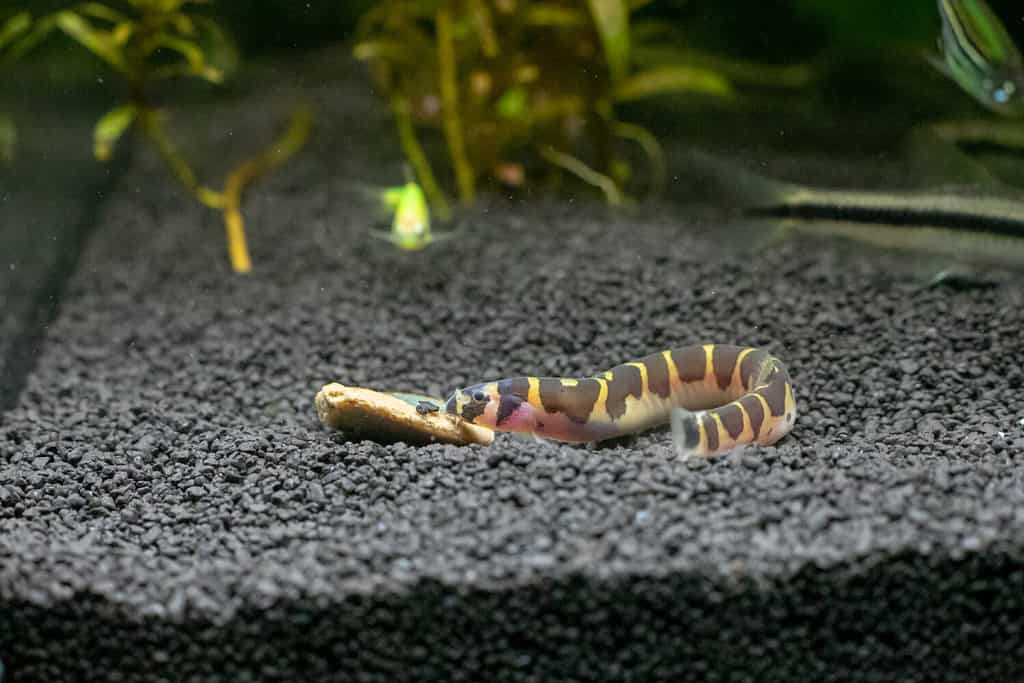
Kuhli loaches swim by wiggling their bodies and propelling themselves using their small pectoral fins.
©Olga Chezhina/Shutterstock.com
Fascinating tank mates that pair well with female betta fish are kuhli loaches, which originate from Southeast Asia. Kuhli loaches look like miniature eels with their elongated bodies and striking patterns. These small loaches grow to around 4 inches long and typically have yellow and brown striped bodies.
Kuhli loaches are bottom-dwelling fish that spend their time burrowing in sandy or fine gravel-like substrates. They are nocturnal fish that are most active at night when the tank lights are turned off. They do not swim near the surface of the water often but will sometimes venture to the mid-section of the tank. Kuhli loaches are naturally social fish, so they prefer to be kept in groups of five or more. They usually burrow and eat together as a group.
3. Chili Rasboras (Boraras brigittae)
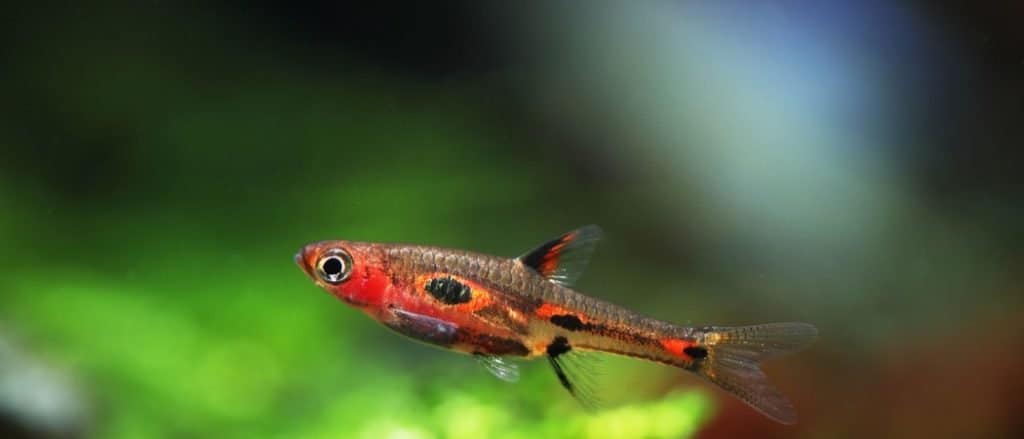
Most chili rasboras only reach a length of 0.7 inches.
©Pavaphon Supanantananont/Shutterstock.com
The chili or mosquito rasbora is a vibrant schooling fish that grows under 1 inch long. These tiny fish are located in the rivers of Southeast Asia, particularly Indonesia and Thailand.
Chili rasboras are perhaps one of the most colorful tank mates you can successfully pair with female bettas. Their bodies are a vivid reddish-orange coloration adorned with blueish-green patterning. They look striking in planted aquariums, which can be as small as 10 gallons. Chili rasboras are relatively easy to care for because they are undemanding pets.
Keeping chili rasboras in a filtered and heated aquarium in groups of six or more is enough to keep them active and happy. Unlike many other small fish, the chili rasbora has a lengthy lifespan of up to 8 years. Most well-cared-for chili rasboras can outlive a female betta fish which only has a lifespan of 3 years.
4. Nerite Snails (Neritina natalensis)

Female betta fish and nerite snails can be housed together in a 5-gallon tank.
©Mark Brandon/Shutterstock.com
Nerites are small freshwater snails which are preferred for their inability to reproduce in most aquariums. Nerite snails’ eggs will only hatch in brackish water conditions, rather than in a female bettas freshwater aquarium. These snails grow between 0.8 to 1 inch in diameter and have uniquely patterned shells. Their shells are either red, orange, yellow, or black coloration with various stripes and dotting.
These snails are omnivores, so they will eat leftover food from female betta fish. Nerite snails enjoy eating green algae from surfaces in the tank and easily form part of an aquarium’s clean-up crew. It is unlikely for nerite snails and female bettas to regularly interact, as nerites keep to themselves in an aquarium.
5. Pygmy Corydoras (Corydoras pygmaeus)

As their name suggests, the pygmy ory is the smallest cory
catfish
, measuring only 1 inch long.
©Pavaphon Supanantananont/Shutterstock.com
The pygmy corydoras is a small species of bottom-dwelling catfish. They originate from South America, specifically from the Aguarico, Mediera, and Nanay rivers. Pygmy corydoras grow around 1.2 to 1.5 inches long as adults, similar to juvenile female betta fish. Their simple appearance consists of a silver or yellow coloration with defined black stripes. Their colors pop against dark aquarium backgrounds and substrates.
Pygmy corydoras mostly swim along the bottom of an aquarium and rarely swim anywhere else unless it’s for food. They tend to stay in groups of five or more to eat, rest, and hide together. They are easily stressed when kept alone and do not do well in pairs, therefore a minimum of five is recommended.
Most female betta fish will leave pygmy corydoras alone, although it is a good idea to add live plants for coverage. Live plants give these small corydoras a place to hide when they are feeling stressed.
6. Mollies (Poecilia sphenops)
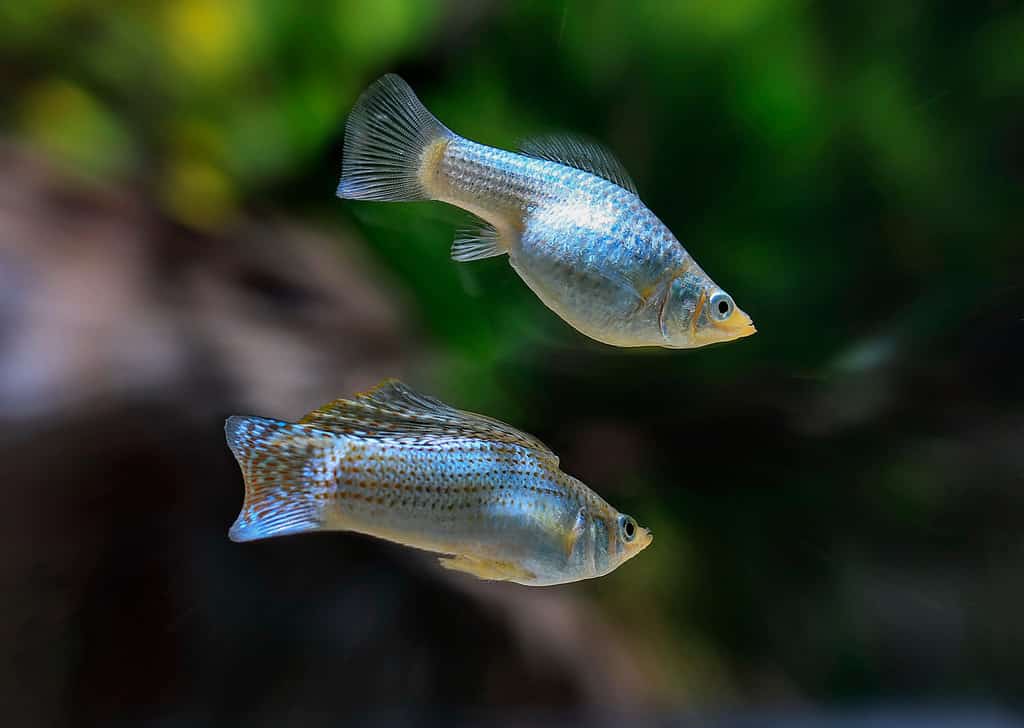
As a type of live-bearing fish, mollies do not lay eggs but rather give birth to free-swimming fry.
©Mr.Sutun photographer/Shutterstock.com
Mollies are popular live-bearing fish that pairs well with female betta fish in spacious aquariums. These fish can grow up to 4 inches long, so their aquarium needs to be well over 20 gallons. Mollies can be found in a range of colors and patterns, but black, silver, white, and golden are most common.
They are social fish with peaceful temperaments and do not pose a risk to female bettas. Mollies need to be kept in groups of five or more to appease their social requirements, so they should never be housed alone. Mollies are comfortable within the same temperature range as female bettas, although they can tolerate slightly colder temperatures.
7. Celestial Pearl Danios (Danio margaritatus)
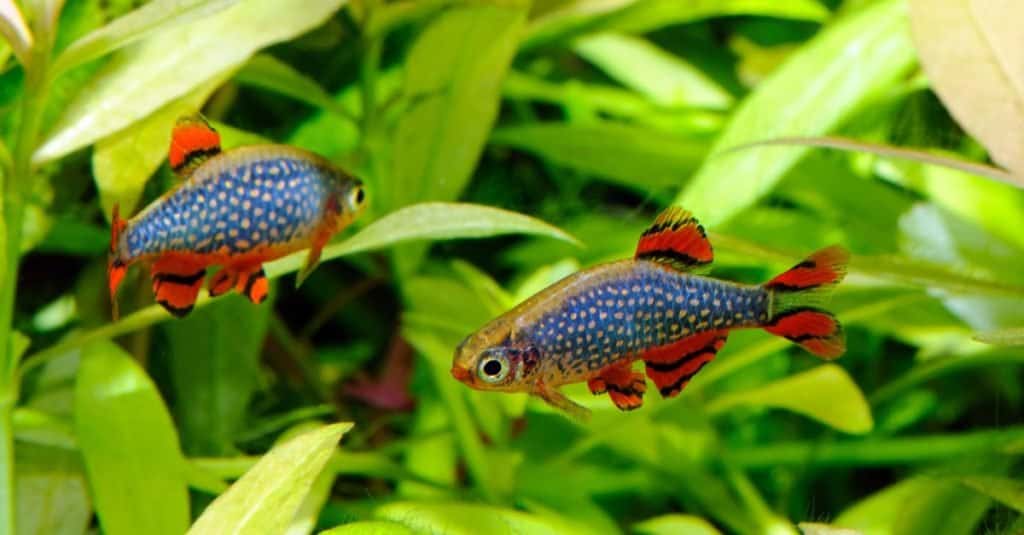
Galaxy rasbora is another name for celestial pearl danios.
©Bos11/Shutterstock.com
The celestial pearl danio is a small species of danio with a striking appearance. These danios are found in Myanmar, but larger populations exist in captivity. Celestial pearl danios grow to about an inch long, but the females are larger. Their appearance is the most captivity thing about these fish, and they can liven up any female betta fish aquarium.
Celestial pearl danios have reddish-orange fins, a blue coloration, and numerous white dots over their bodies. The males generally have a more vibrant appearance than the females who appear duller. Celestial pearl danios should be housed in groups of six or more because they are shoaling fish that benefit their own company.
Thanks to their small size, you can easily house a group of these danios in a 16-gallon or larger female betta fish aquarium.
8. Guppies (Poecilia reticulata)
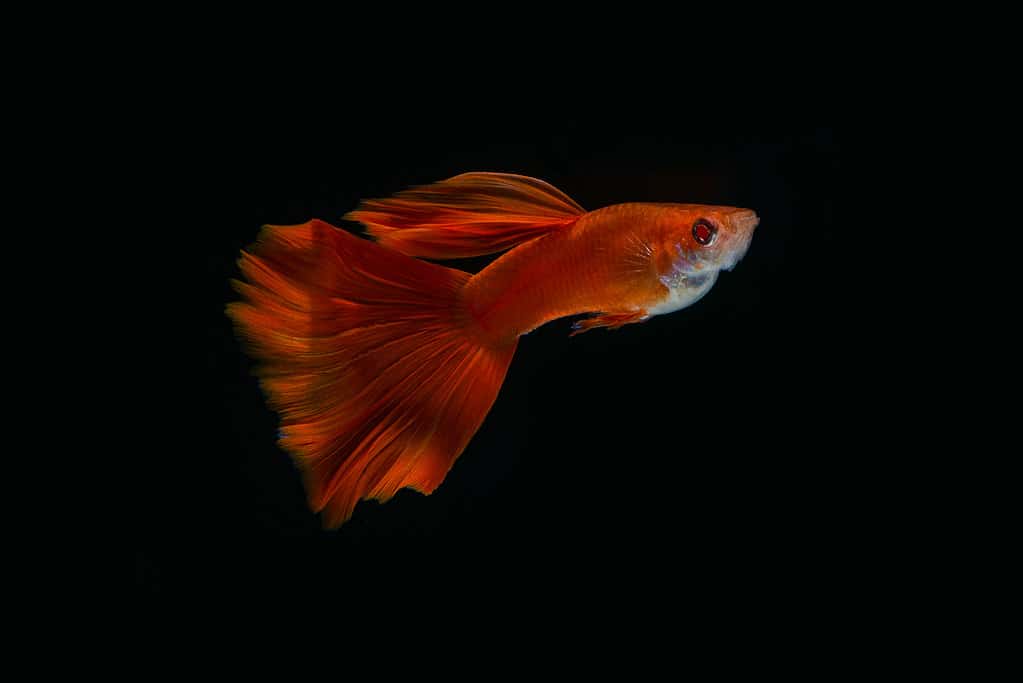
Long-finned guppies are not suitable tank mates for female betta fish, because they are susceptible to fin nipping.
©Norrapat Thepnarin/Shutterstock.com
Another popular live-bearing fish aside from mollies is guppies, also known as millionfish. Guppies belong to the Poeciliidae family, which contains various species of live-bearing fish. You can find guppies in ponds, swamps, and rivers throughout South America, although they are found abundantly in the aquarium trade.
Guppies are small fish ranging from 1.5 to 2.5 inches long. These fish are found in various colors, patterns, and fin shapes that make them fascinating additions to female betta fish aquariums. However, certain precautions need to be taken when housing them together.
Only the short-finned guppies are compatible with female bettas to prevent fin-nipping behaviors. Few female bettas can resist biting at a guppy’s fins, which is understandably stressful for the guppies.
Alternatively, you can house female guppies with female betta fish, since they are slightly larger and generally have shorter fins than the males.
9. Mystery Snails (Pomacea diffusa)
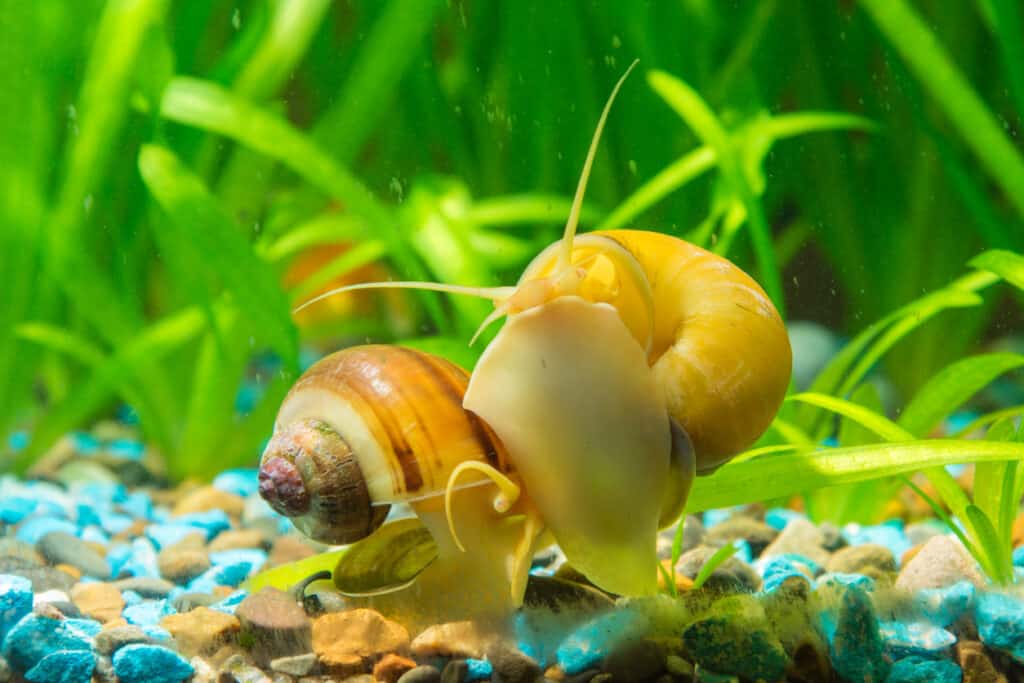
A mystery snail shell can either be blue, golden, brown, green, purple, or chestnut.
©iStock.com/Madhourse
Mystery snails are popular freshwater snails known for their impressive shell colorations and large size. They typically grow around 2 inches in size, making them one of the largest aquarium snails. Mystery snails are fairly peaceful and liven up aquariums with their quirky behaviors, activeness, and ease of care. Female bettas and mystery snails will get along just fine in a 10-gallon or larger aquarium. Mystery snails do not need to be housed in groups if you want to avoid breeding them. However, female betta fish may enjoy eating a mystery snail’s eggs which are rich in protein.
10. Dwarf Loaches (Ambastaia sidthimunki)

Dwarf loaches go by many names, but commonly ones that describe their size or appearance.
©Pavaphon Supanantananont/Shutterstock.com
The dwarf loach or pygmy loach is a tiny bottom-dwelling fish originating from northern India and Thailand. Dwarf loaches have an average size of 2 inches and have a golden coloration with dark chain-like markings. These small loaches spend most of their time at the lower level of an aquarium. They display many interesting behaviors, such as foraging and algae-eating. Dwarf loaches are naturally social fish, so you need to keep five or more together.
Their peaceful and social temperaments make them perfect for spacious female betta fish aquariums. They thrive at the same temperatures as female bettas and require similar water conditions to be healthy. Dwarf loaches have an average lifespan of 8 to 12 years, so be prepared to care for these fish for the next decade.
11. Harlequin Rasboras (Trigonostigma heteromorpha)
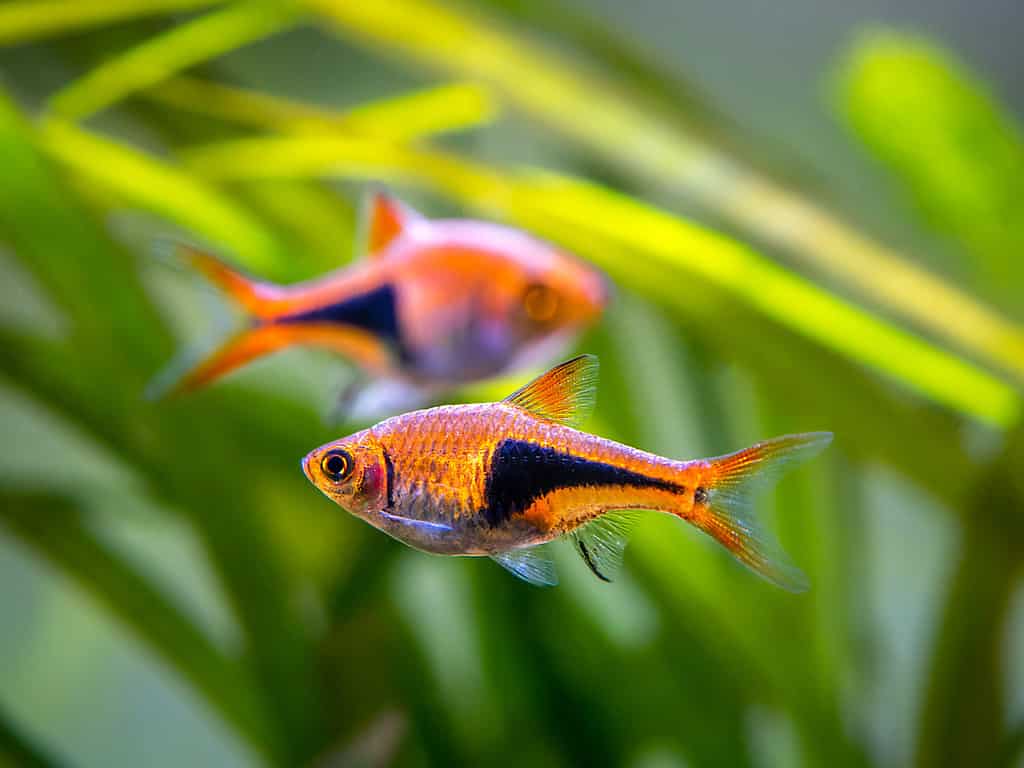
Harlequin rasboras are one of the most popular schooling fish in the world because they are easy to care for.
©Joan Carles Juarez/Shutterstock.com
The stunning harlequin rasbora has a distinctive orange body and black triangular marking near their caudal fin. They are small fish at 2 inches long and originate from densely vegetated waters throughout Southeast Asia. Harlequin rasboras are one of the most popular species of rasboras kept in aquariums. Their popularity as pets arose in the 1900s and has remained steady even decades later.
Harlequin rasboras can be perfect additions to large and planted female betta fish aquariums. They are naturally peaceful and social fish that rarely fin-nip other fish. They need to be kept in groups of six or more to form schools. A 20-gallon long tank can accommodate a small school of harlequin rasboras and a single female betta fish. The tank should be filtered and heated with plenty of live plants to provide both fish with coverage.
12. Ember Tetras (Hyphessobrycon amandae)

The bright colors of the ember tetra make them desirable fish to keep in aquariums.
©nektofadeev/Shutterstock.com
Ember tetras are easily recognized by their fiery coloration which has earned them their name. They are mainly a reddish-orange color, with a hint of grey at the ends of their fins. These tetras reach an inch long in aquariums, but some only grow to 0.8 inches. Aside from being easy to care for in aquariums, ember tetras can be found in the Araguaia River Basin in Brazil.
These fish prefer heavily planted aquariums which make them feel safe. Ember tetras are more active when they are kept in good water quality, in groups of six or more, and in spacious aquariums. They are relatively peaceful fish that can add a dash of color to female betta fish tanks if it is kept heated and filtered.
13. Golden Bristlenose Plecostomus (Ancistrus cirrhosis)
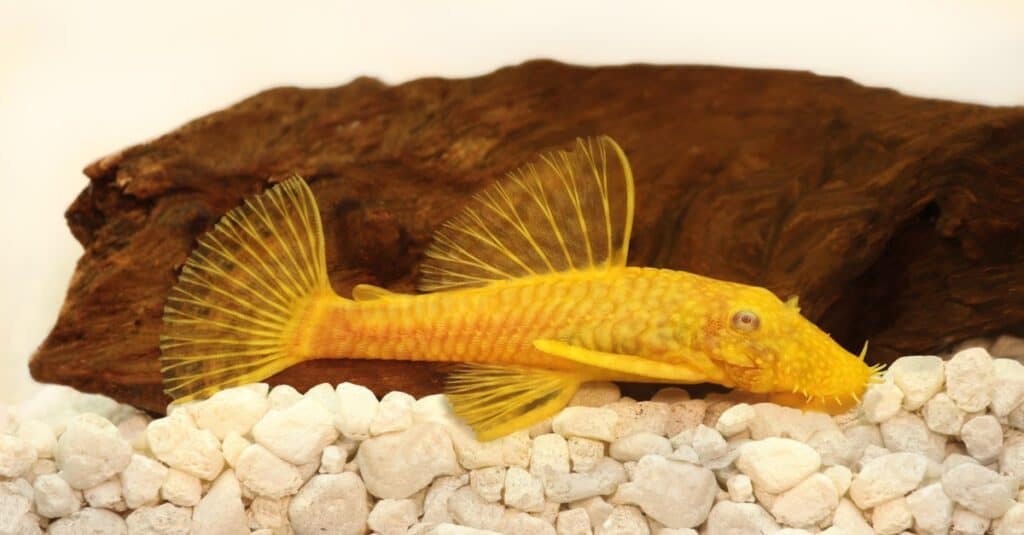
The bristlenose pleco is popular among the smallest pleco fish, which makes them popular.
©iStock.com/Mirko_Rosenau
The golden bristlenose pleco is the last fish on our list—a bottom-dwelling fish originating from South America. As their names suggest, these plecos are a striking golden coloration with clusters of tentacles around their mouths. They grow between 3 to 5 inches long and require a minimum tank size of 25 gallons when paired with female bettas.
Golden bristlenose plecos are low-maintenance pets and easy to keep in community aquariums. They enjoy a spacious aquarium with tropical conditions and well-maintained water quality to thrive. These plecos do not need to be kept together, although they appreciate being kept in small groups.
Driftwood is an important part of a golden bristlenose plecos diet in both captivity and the wild. The wood provides them with essential fibers needed for their digestion. It is recommended to add a small piece of driftwood into the female bettas tank if you plan to house them with these plecos.
Female Betta Fish Sororities
Keeping female betta fish together in groups of three or more is known as a “sorority”. This does not apply to male betta fish though, who should never be kept together once they are mature. It is challenging to keep female bettas together in the same tank, which is why it is only recommended for experienced fish keepers. Betta fish are perfectly content living a solitary lifestyle and do not crave companionship as social fish do.
Furthermore, female bettas should never be housed with male betta fish. This put both fish at risk of death and serious injuries, along with constant stress from both sides. Male and female betta fish should encounter each other for a short period while breeding.
Unfortunately, female betta fish sororities have a low success rate, and the group may fall out over time. Female bettas might not be as aggressive as the males, but they do not always enjoy sharing their space. Chasing and fin-nipping behavior is a common issue in female betta sorority tanks, as one betta will always be more dominant than the others.
Female betta fish sororities take a lot of time, planning, housing considerations, and knowledge that the average hobbyist does not have. Plus, you will need to have backup tanks with filters, heaters, and other aquarium equipment in case you need to separate them.
The Worst Tank Mates for Female Betta Fish
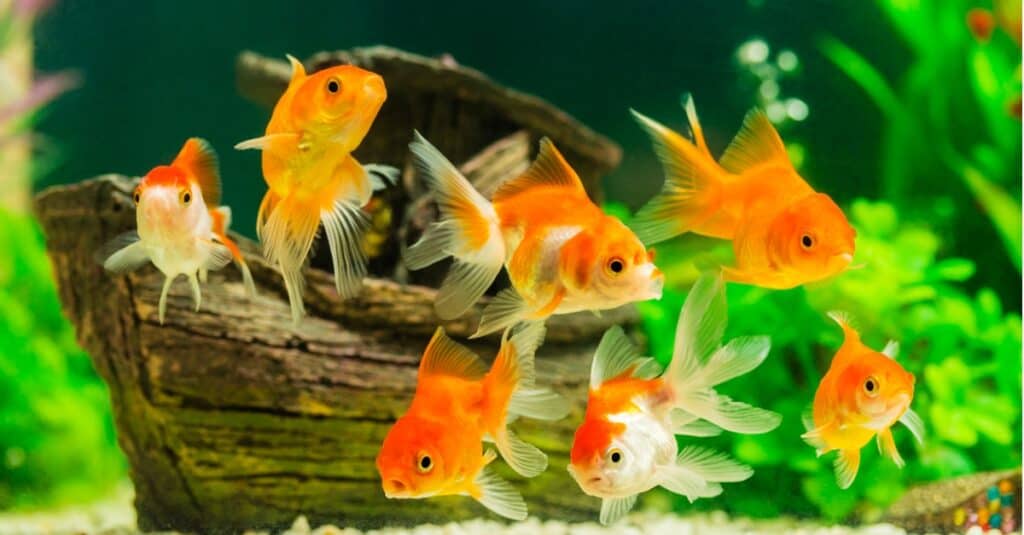
Goldfish should never be housed with betta fish because of their different aquarium requirements.
©iStock.com/satit_srihin
- Goldfish
- Oscars
- Jack Dempsey
- Arowanas
- Koi
- Angelfish
- Shrimp
- Parrot fish
- African cichlids
- Gourami
- Any marine species
- Common Plecostomus
Conclusion
The best tank mates for female bettas are other peaceful, small, and tropical fish or snails. Neon tetras, nerite snails, and kuhli loaches seem to be the most recommended tank mates for female bettas. Keep in mind that you should only house female bettas with tank mates if the aquarium conditions are ideal.
Summary Of The 13 Ideal Tank Mates to Pair With Female Betta Fish
| Rank | Tank Mates |
|---|---|
| 1 | Neon tetras |
| 2 | Kuhli loaches |
| 3 | Chili rasboras |
| 4 | Nerite snails |
| 5 | Pygmy corydoras |
| 6 | Mollies |
| 7 | Celestial pearl danios |
| 8 | Guppies |
| 9 | Mystery snails |
| 10 | Dwarf loaches |
| 11 | Harlequin rasboras |
| 12 | Ember tetras |
| 13 | Golden bristlenose Plecostomus |
The photo featured at the top of this post is © Praisaeng/Shutterstock.com
Thank you for reading! Have some feedback for us? Contact the AZ Animals editorial team.



